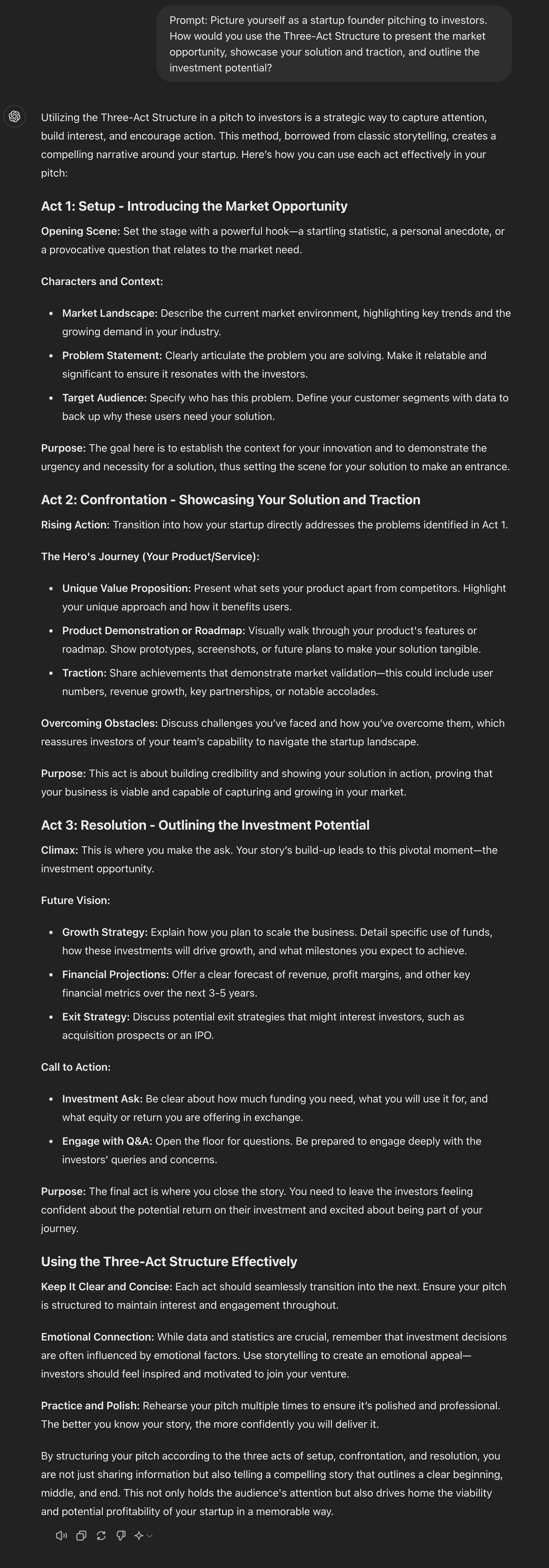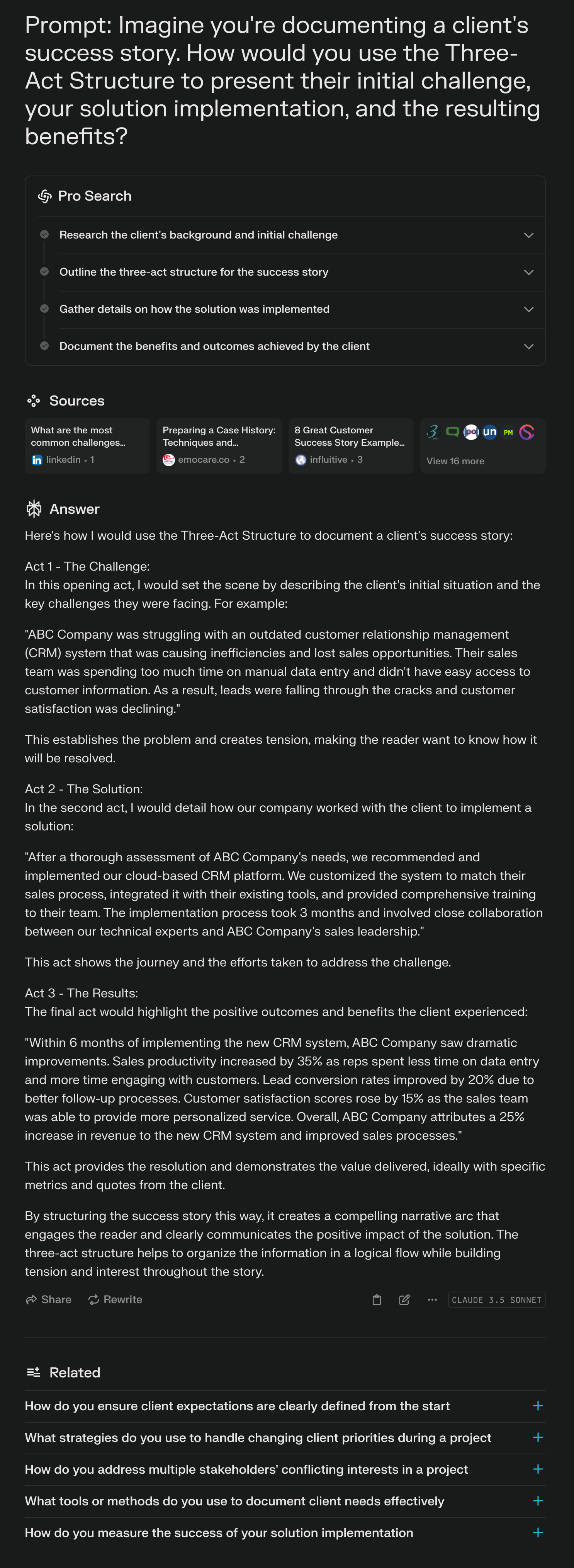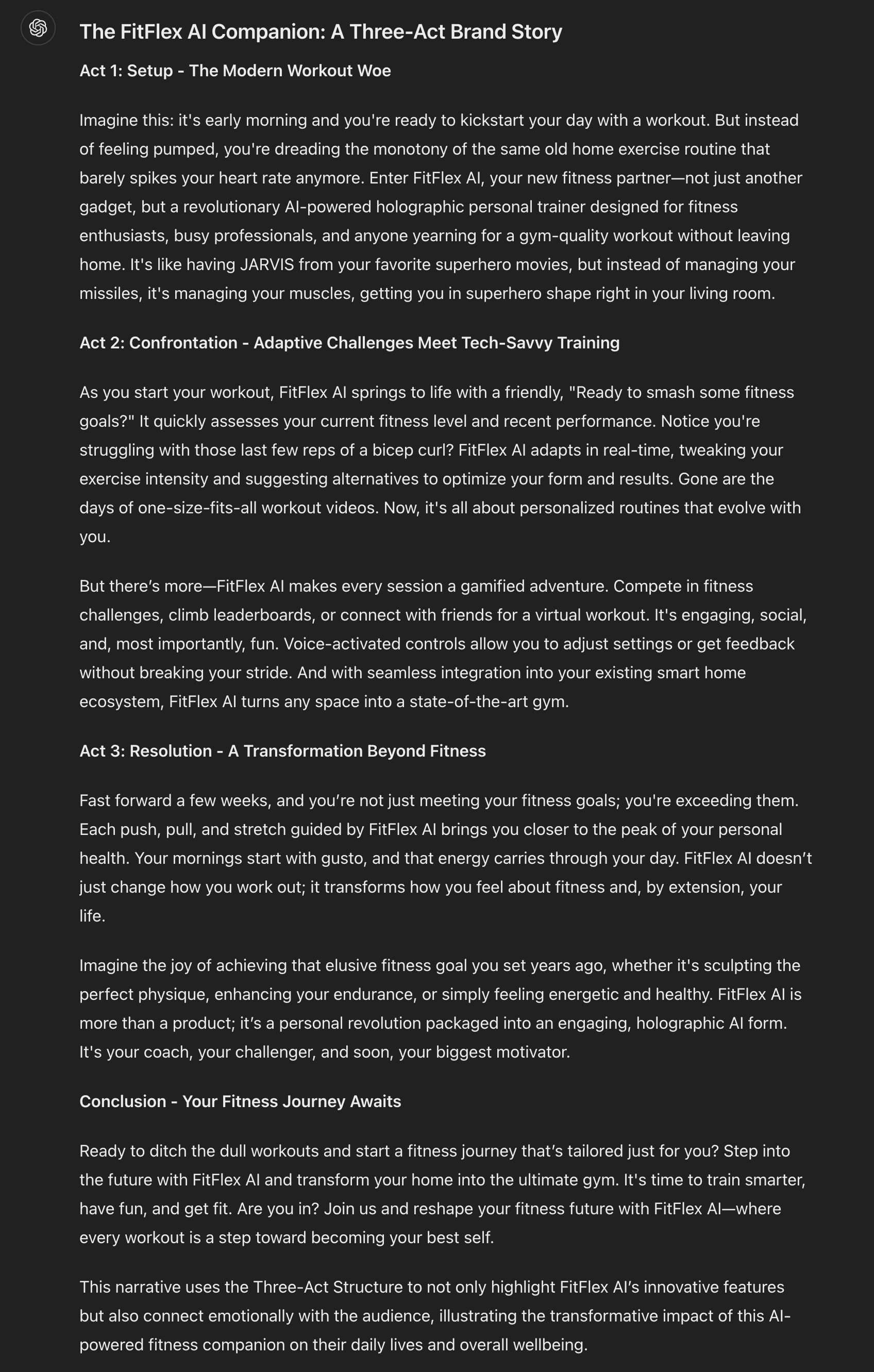What is the Three-Act Structure?
The Three-Act Structure is a classic narrative framework that divides a story into three distinct parts:
- Setup
- Confrontation, and
- Resolution
It’s a fundamental storytelling template used across various mediums, from novels and plays to films and marketing campaigns.
In Act One, or the Setup, the story introduces the main characters, establishes the setting, and presents the central conflict or problem that the protagonist must face.
This act often includes an inciting incident that sets the story in motion and propels the character into the main plot.
An Example of Act One (Setup): In the film “The Matrix”, Act One introduces Thomas Anderson (Neo), a computer programmer living a mundane life. The inciting incident occurs when Neo receives a mysterious message on his computer, leading him to meet Trinity and Morpheus. This sets up the central conflict – Neo’s discovery that the world he knows is actually a simulated reality called the Matrix, and he must choose whether to learn the truth about his existence.
Act Two, known as the Confrontation, is where the protagonist faces various obstacles and challenges while trying to solve the central problem introduced in Act One.
This act is usually the longest and involves the rising action, leading to a climax or turning point.
An Example of Act Two (Confrontation): In J.K. Rowling’s “Harry Potter and the Philosopher’s Stone”, Act Two comprises Harry’s first year at Hogwarts. He faces various challenges and obstacles, including learning magic, making friends and enemies, and uncovering the mystery of the Philosopher’s Stone. The rising action includes confrontations with the troll, solving puzzles to reach the Stone, and discovering Voldemort’s involvement. This act builds tension and develops Harry’s character as he prepares for the final confrontation.
Finally, Act Three, or the Resolution, is where the story’s conflicts are resolved, and the character arcs are concluded.
This act often includes the climax, where the protagonist faces the ultimate challenge, and the denouement, where the story’s loose ends are tied up.
An Example of Act Three (Resolution): In the movie “The Shawshank Redemption”, Act Three begins with Andy Dufresne’s escape from prison. The climax occurs when Red discovers the truth about Andy’s escape and follows his instructions to find him. The denouement shows Red being paroled, struggling with life outside prison, and ultimately deciding to follow Andy’s path. The story concludes with Red reuniting with Andy on a beach in Mexico, resolving the main conflicts and completing both characters’ arcs towards freedom and hope.
How does the Three-Act Structure help you in business?

Here are 10 examples with prompts for each.
- Marketing campaigns: Structuring a marketing campaign using the Three-Act Structure can create a compelling narrative that engages the audience. Act One introduces the problem, Act Two presents the product or service as the solution, and Act Three shows the resolution and benefits.
Prompt: Imagine you’re directing a mini-movie about your customer’s journey. How would you use the Three-Act Structure to introduce their problem, present your product as the hero, and showcase the happily-ever-after ending?
- Sales presentations: Using the Three-Act Structure in sales presentations can help salespeople tell a persuasive story. Act One establishes the customer’s pain points, Act Two introduces the product as the solution, and Act Three demonstrates how the product resolves the customer’s issues.
Prompt: You’re a master chef preparing a three-course meal for potential investors. How would you use the Three-Act Structure to present your appetizer (problem), main course (solution), and dessert (benefits) to leave them craving more?
- Brand storytelling: Brands can use the Three-Act Structure to create a compelling brand story. Act One introduces the brand’s origins and mission, Act Two presents the challenges the brand has faced, and Act Three shows how the brand has overcome these challenges and continues to grow.
Prompt: Pretend you’re writing your brand’s biography. How would you use the Three-Act Structure to introduce your brand’s origins, highlight its challenges, and showcase its triumphant growth?
- Product launches: Launching a new product using the Three-Act Structure can create excitement and anticipation. Act One teases the problem the product solves, Act Two reveals the product and its features, and Act Three shows how the product benefits the customer.
Prompt: You’re creating a teaser campaign for a new product. How would you use the Three-Act Structure to hint at a problem, build anticipation for your solution, and reveal the product’s benefits?”
- Customer testimonials: Structuring customer testimonials using the Three-Act Structure can create powerful social proof. Act One introduces the customer’s problem, Act Two shows how the product or service solved it, and Act Three reveals the positive outcomes the customer experienced.
Prompt: Imagine crafting a customer success story. How would you use the Three-Act Structure to present their initial struggle, your product’s intervention, and the positive transformation they experienced?
- Email marketing: Applying the Three-Act Structure to email marketing campaigns can boost engagement and conversions. Act One presents a problem or opportunity, Act Two introduces the solution, and Act Three includes a clear call-to-action.
Prompt: You’re scripting a three-part email series. How would you use the Three-Act Structure to introduce a challenge, present your solution, and motivate action in the final email?
- Investor pitches: Entrepreneurs can use the Three-Act Structure to create compelling investor pitches. Act One introduces the market opportunity, Act Two presents the company’s solution and traction, and Act Three outlines the investment opportunity and potential returns.
Prompt: Picture yourself as a startup founder pitching to investors. How would you use the Three-Act Structure to present the market opportunity, showcase your solution and traction, and outline the investment potential?
- Employee onboarding: Using the Three-Act Structure for employee onboarding can create a memorable and engaging experience. Act One introduces the company’s history and culture, Act Two presents the employee’s role and responsibilities, and Act Three shows how the employee can grow and succeed within the company.
Prompt: You’re designing an onboarding program. How would you use the Three-Act Structure to introduce your company culture, outline the employee’s role, and show their potential growth path?”
- Case studies: Structuring case studies using the Three-Act Structure can showcase the value of a product or service. Act One introduces the client’s challenge, Act Two shows how the solution was implemented, and Act Three reveals the results and benefits.
Prompt: Imagine you’re documenting a client’s success story. How would you use the Three-Act Structure to present their initial challenge, your solution implementation, and the resulting benefits?
- Thought leadership content: Applying the Three-Act Structure to thought leadership content, such as blog posts or whitepapers, can create engaging and persuasive narratives. Act One presents an industry problem or trend, Act Two offers unique insights and solutions, and Act Three provides actionable takeaways for the reader.
Prompt: You’re writing an industry trend article. How would you use the Three-Act Structure to introduce a pressing issue, offer your unique insights, and provide actionable takeaways for your readers?
Prompt 7, Investor pitches, tested in ChatGPT 4 Plus.

Prompt 9, Case Studies, tested using Perplexity.

A Fictional Product Brief

This is a dummy product brief that you can use to test the AI Recipe below. You can also modify this structure to fit your own brand story.
The FitFlex AI Companion
Target Audience: Fitness enthusiasts, busy professionals, and tech-savvy individuals looking for personalized home workouts
Goal: Create an engaging AI-powered fitness companion that revolutionizes home workouts
Industry/Vertical: Smart Home Fitness Technology
Product Highlights
- AI-powered holographic personal trainer
- Adaptive workout routines based on real-time performance
- Gamified fitness challenges and social connectivity
- Voice-activated controls and feedback
- Integration with existing smart home devices
Story Structure
- Act 1 (Setup): Introduce the FitFlex AI as the solution to boring, ineffective home workouts
- Act 2 (Confrontation): Showcase how FitFlex AI adapts to user’s fitness level and overcomes common workout obstacles
- Act 3 (Resolution): Demonstrate the transformative impact on users’ fitness journeys and daily livesStyle: Captivating, futuristic, with a touch of humorTone: Friendly, encouraging, slightly sassy (think JARVIS meets your fittest friend)
- Focus: The joy of personalized, effective workouts without leaving home
Additional Notes
- Use pop culture references to make the AI relatable (e.g., “I’m like JARVIS, but I’ll make you look like Thor”)
- Highlight the product’s ability to turn any space into a cutting-edge gym
- Emphasize the balance between high-tech features and user-friendly interface
AI Recipe For Three-Act Structure
- For this technique, we shall use the RATS Framework, an elegant method I developed for writing prompts. It provides the context clues and structure to help GPTs frame and answer problems.
- Before using RATS prompts, ensure you have clearly defined the problem and constraints using the Problem Statement or Product Brief Methods from Phewture. You can also use the brief above and modify it as you please.
- If this this your first foray on Phewture, do familiarize yourself with the Basics of Prompting.
Begin prompt
Complete the tasks outlined below one step at a time. After each step ask for my permission before moving on to the next step. If a step takes more than one message to complete, send “Continue” to proceed to the next message. Provide a complete detailed response without worrying about message length. Let me know when you are ready for me to provide the brief.
Step 1: [Insert Product Brief: User Inputs]
- Product/Service: [Insert detailed description of the product or service, including main features and unique selling points.]
- Target Audience: [Insert key demographics and characteristics of the audience, such as age, interests, and specific needs or challenges.]
- Industry/Vertical: [Insert the specific industry or vertical the product/service belongs to.]
- Audience Challenges: [Insert the main challenges or pain points the audience faces.]
- Key Elements/Messages: [Insert any important points, themes, or messages to be highlighted in the story.]
- Transformation/Outcome: [Insert the transformation or positive outcome the brand enables for the audience.]
- Call-to-Action: [Insert the desired action you want the audience to take after engaging with the story.]
Step 2: Apply this prompt below to the User Inputs
[Role] = Act as an expert in the Three-Act Structure and strategic storytelling. Your key traits include deep knowledge of the three acts and story beats. You have the ability to map business narratives to this structure, skills in crafting compelling stories that engage audiences, creativity in making stories memorable and actionable, logical approach to structuring narratives, clear communication to explain concepts, and adaptability to tailor stories to different goals.
[Avatar] = [Target Audience] with [Audience Challenges]
[Topic] = Apply the Three-Act Structure to craft compelling brand stories in [Industry/Vertical]. The Three-Act Structure has a Setup that introduces characters and conflict, a Confrontation with rising action and challenges, and a Resolution that provides a satisfying conclusion.
[Task] = Help me create an engaging brand story using the Three-Act Structure for this scenario: [Product/Service] aimed at [Target Audience]. Key elements to include are: [Key Elements/Messages, CTA].
[Structure] =
- Setup: Introduce relatable characters and the challenges [Audience Challenges] they face.
- Rising Action: Build rising action as the brand helps resolve those challenges.
- Climax: Highlight the positive transformation [Transformation/Outcome] the brand enables.
- Resolution: Paint a picture of a better future with the brand.
- Close: End with a clear call-to-action: [Call-to-Action].
[Style & Tone] = Craft the story in a captivating style that connects emotionally with the audience. Use a friendly, conversational tone, speaking directly to “you.” Incorporate vivid details and examples to make the story memorable. Focus on dimensionalized benefits to the audience and not just brand features.
End prompt
This prompt template provides a framework to leverage the Three-Act Structure for impactful brand storytelling. It defines the expert’s role, target audience, topic, specific task, story flow, and communication style – enabling the creation of narratives that resonate with audiences and inspire them to engage with the brand.
Ensure that you customize each element for your unique brand, offerings and customers.
Tested FitFlex Brief With Prompt in ChatGPT 4 Plus.

AI Tools that you can use
You can use any one of ChatGPT, Claude, Gemini Pro, or the free llama 3 LLM for trying out the techniques discussed on Phewture.
Or if you crave variety, then use Perplexity,ai [select Perplexity, or Claude Models], or Poe [select from multiple models such as Claude, GPT4, etc].
Read this article on Phewture for how to install LLMs on your desktop.
Next Steps
- To help you find your way around Phewture, I have put together a set of AI Recipes under Wayfinding. Do go through these and you’ll navigate like a pro through this stream of consciousness. 😄
- The Learning Methods are exercises that I’d recommend if you wish to wrap your head around the possibilities of using AI Recipes at work, or for play.
- Don’t forget to leave your comments below and share your joy with your friends on social media. Use the share icons below this post to gain some good karma.
Wish to train your in-house team on AI techniques?

Phewture offers AI-spurred training for teams. Do check out the Training Services.
While you enjoy your sojourns here, I’d love to have your feedback. Use the comment box below and let it rip.

